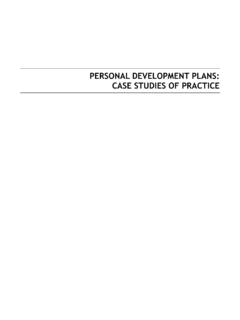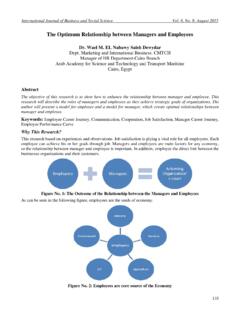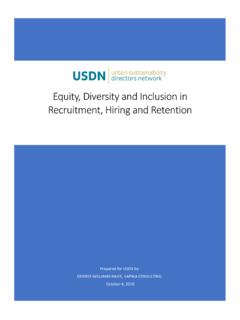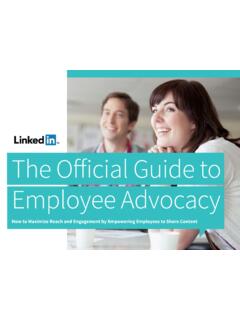Transcription of Employee Engagement: A review of current thinking
1 Employee engagement A review of current thinking Gemma Robertson-Smith and Carl MarkwickREPORT 469 Published by: INSTITUTE FOR EMPLOYMENT STUDIES Mantell Building University of Sussex Campus Brighton BN1 9RF UK Tel: +44 (0) 1273 686751 Fax: +44 (0) 1273 690430 Copyright 2009 Institute for Employment Studies No part of this publication may be reproduced or used in any form by any means graphic, electronic or mechanical including photocopying, recording, taping or information storage or retrieval systems without prior permission in writing from the Institute for Employment Studies. ISBN 978 1 85184 421 0 Institute for Employment Studies IES is an independent, apolitical, international centre of research and consultancy in HR issues.
2 It works closely with employers in all sectors, government departments, agencies, professional bodies and associations. IES is a focus of knowledge and practical experience in employment and training policy, the operation of labour markets, and HR planning and development. IES is a not for profit organisation. iii Contents Summary v 1 Introduction 1 Why is engagement of importance and interest? 1 IES research to date 3 Purpose of review 4 Method 4 2 What is engagement ? 5 Defining engagement 6 3 Outcomes of engagement 16 Organisational outcomes 17 Employee outcomes 20 The downside of engagement 21 4 Variations in Employee engagement 23 Are some people more likely to engage than others?
3 24 5 Enabling engagement in Practice 28 Drivers of engagement 29 Barriers to engagement 39 In summary 40 6 Measuring Employee engagement 43 Existing measures 44 Acting on feedback 47 7 Areas of Overlap With Other Concepts 48 Similar concepts 49 General thoughts 52 iv 8 Conclusion 53 Developing a culture supportive of engagement 53 Future research into engagement 55 Bibliography 56 Related Publications 65 v Summary 1. engagement is consistently shown as something given by the Employee which can benefit the organisation through commitment and dedication, advocacy, discretionary effort, using talents to the fullest and being supportive of the organisation s goals and values.
4 Engaged employees feel a sense of attachment towards their organisation, investing themselves not only in their role, but in the organisation as a whole. 2. Engaged employees are more likely to stay with the organisation, perform 20 per cent better than their colleagues and act as advocates of the business. engagement can enhance bottom line profit and enable organisational agility and improved efficiency in driving change initiatives. Engaged individuals invest themselves fully in their work, with increased self efficacy and a positive impact upon health and well being, which in turn evokes increased Employee support for the organisation. 3. engagement levels can vary according to different biographical and personality characteristics.
5 Younger employees may be positive when they first join an organisation, but can quickly become disengaged. Highly extravert and adaptable individuals find it easier to engage. engagement is a choice, dependent upon what the Employee considers is worth investing themselves in. 4. engagement levels vary according to seniority, occupation and length of service in an organisation but not by sector. The more senior an individual s role, the greater the chance of being engaged. Presidents, managers, operational and hands on staff tend to be the most engaged, professionals and support staff the least, but this varies between organisations. 5. There are seven commonly referenced drivers of engagement : the nature of the work undertaken, work that has transparent meaning and purpose, development opportunities, receiving timely recognition and rewards, building respectful and assertive relationships, having open two way communication systems and inspiring leadership.
6 Vi 6. There are a variety of measures of engagement available. However, the lack of a clear definition of Employee engagement and the differing requirements of each organisation means there is likely to be considerable variation in what is measured in these surveys. 7. Being satisfied at work is a weaker predictor of business outcomes than engagement and lacks the two way reciprocal relationship characteristic of engagement . There is a very strong relationship between organisational citizenship and engagement , as both focus upon going beyond the expected. Both engagement and the psychological contract have a cognitive and emotional element and can depict the two way Employee employer 1 1 Introduction Why is engagement of importance and interest?
7 In his 2004 book entitled The New Rules of engagement , Mike Johnson wrote the ability to engage employees, to make them work with our business, is going to be one of the greatest organisational battles of the coming 10 years (p. 1). Five years on and Employee engagement is now a management hot topic and one which has quickly absorbed into the HR agenda. It is a key challenge which is capturing the attention of executives and HR professionals alike (Soldati, 2007; HR Focus, 2006) and, increasingly, the acceptance of academics. Today, it is a rare to find articles in the popular HR or management press without some mention of engagement and how to enable it. Yet, to date there is no one clear and agreed definition of engagement and many researchers and practitioners describe the term in very different ways (Soldati, 2007).
8 Nevertheless, there is an increasing awareness that Employee engagement is pivotal to successful commercial and business performance, where engaged employees are the backbone of good working environments where people are industrious, ethical and accountable (Levinson, 2007a; Cleland et al, 2008). engagement can affect employees attitudes, absence and turnover levels and various studies have demonstrated links with productivity, increasingly pointing to a high correlation with individual, group and organisational performance, a success measured through the quality of customer experience and customer loyalty (Hemsley Fraser, 2008, cited in The HR Director, 2008; The Conference Board, 2006).
9 Organisations with higher engagement levels tend to have lower Employee turnover, higher productivity, higher total shareholder returns and better financial performance (Baumruk, 2006). Towers Perrin (2007) found that organisations with the highest percentage of engaged employees increased their operating income by 19 per cent and their earnings per share by 28 per cent year to year. Highly engaging organisational cultures may also have an attractive 2 Employee engagement : a review of current thinking employer brand, being an employer of choice which attracts and retains the best talent (eg Martin and Hetrick, 2006). By building a culture that enables employees to engage in their work, organisations may benefit from staff who are willing to go the extra mile and achieve better financial performance (Baumruk, 2006).
10 However, despite the potential gains of improved engagement levels, Gallup found that more than 80 per cent of British workers are not truly committed to their work, and a quarter of these are dissatisfied and actively disengaged , putting no passion into their work (Flade, 2003). Gallup (2006) proposed that employees could be divided into three types with regard to their level of engagement , the engaged, not engaged and the actively disengaged, with the later being of most concern to the employer brand as a result of sharing their discontent with their co workers and the wider world (see Figure ). Hukerby (2002, cited in Pech and Slade, 2006) suggested that 20 per cent of employees in the UK are disengaged, having mentally quit , yet they continue to stay with the company.

















